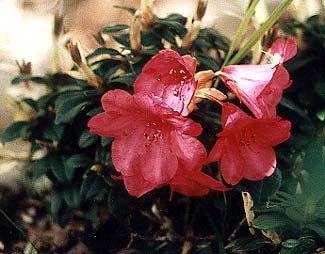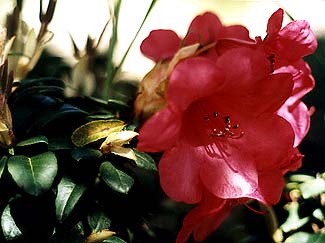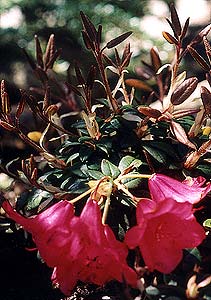 Rhododendron
Rhododendron
'Whisperingrose'
"Nature, exerting an unwearied power,
Forms, opens, & gives scent to every flower;
Spreads the fresh verdure of the field, & leads
The dancing Naiads through the dewy meads."
-William Cowper
(1731-1800)
(1731-1800)
The dwarf rhododendron cultivar 'Whisperingrose' is an unregistered Pacific Northwest hybrid produced by Harold E. Greer of the world-famed Greer Gardens in Eugene. Greer is, of course, the author of the indespensible Greer's Guidebook to Available Rhododendrons Species & Hybrids.
His little shrub was introduced to the world in 1982. It was derived from Rhododendron williamsianum pollinated by the hybrid 'Elizabeth' which is R. forrestii pollinated by R. griersonianum. Elizabeth itself is a dwarf that only reaches three feet in ten years, but R. williamsianium wouldn't even reach two feet in ten years, & of Elizabeth's parents, R. forrestii even though it's ten year height can sometimes be only two feet, it frequently stunts out at a scant six inches! 'Whisperingrose' is lucky to reach two or three feet in ten years, & is frequently smaller, but due to its miniature forebears, it begins blooming & behaving like a mature shrub even when it is a six-inch tall, leafy youngster. It is best placed at the fore of any arrangement of shrubs, since even some groundcovers could hide it.
Given its heritage & averages, we were surprised that it trippled its size in three years. I have to assume it will slow down from now on, but I did have to transplant it
 The large coral to salmon-pink flowers on a small-leafed one-foot high shrub blooms in late April through the first half of May. The flowers are flawless inside & out, a trait of its key parent, which R. williamsianum also passed along to another Northwest cultivar, 'Brickdust' Rhododendron.
The large coral to salmon-pink flowers on a small-leafed one-foot high shrub blooms in late April through the first half of May. The flowers are flawless inside & out, a trait of its key parent, which R. williamsianum also passed along to another Northwest cultivar, 'Brickdust' Rhododendron. In the April portrait above you can make out two inches of new leaf growth just beginning. These new stems begin with filmy yellowish leaves on the side of the new stems. In a couple of weeks these will have grown to their full size as ruddy-copper to milk-chocolate leaves, curled lengthwise into the shapes of cigars.
The first two photos on this page are no less than a week too soon to see the transiently ruddy young leaves, but the third photo on this page (below, taken early in May) shows the leaves' progression. Note also that the long-lasting blooms haven't faded yet, so there are two kinds of leaves plus blossoms for a little while to go. You can also see this interesting behavior conveyed in one of the photos on the 'Brickdust' page.
 About mid-May the bloom is gone & the ruddy new leaves are uncurled. Well before June they will have hardened into dark green, but for a while it looks like two distinct kinds of leaves are on the shrub, & the new ones are almost as decorative as blossoms. For such a little dwarf as 'Whisperingrose,' however, putting on a full two or three inches of height in a single burst of spring growth. In three years it more than doubled its size. This rate of growth is not quite normal & is probably due to it having been initially planted in too deep a shade, starting it questing for more sun.
About mid-May the bloom is gone & the ruddy new leaves are uncurled. Well before June they will have hardened into dark green, but for a while it looks like two distinct kinds of leaves are on the shrub, & the new ones are almost as decorative as blossoms. For such a little dwarf as 'Whisperingrose,' however, putting on a full two or three inches of height in a single burst of spring growth. In three years it more than doubled its size. This rate of growth is not quite normal & is probably due to it having been initially planted in too deep a shade, starting it questing for more sun.In 2004 it had a second very tepid blooming in late July & early August, which is not ordinarily to be expected, though the occasional out-of-season bloom on sundry rhodies no longer takes me entirely by surprise.
In the garden it prefers full sun or only a little shade. Ours alas had insufficient sun this past year, because other shrubs rapidly outgrew it & hemmed it in. In consequence in 2003 it bloomed less well than the year before; it set only a single truss of buds on the morning-sun side of the deep shade in which it found itself in.
I hate to move shrubs after they're settled in a year or two, but the combination of too little sun to set many buds, & increasing its size much faster than I'd been led to believe was likely, meant it had to be dug up. At least rhodies & azaleas have shallow roots & suffer minimally from disruption, so this one was moved very easily to another location in May a couple of weeks after these three photos were taken, when its one large truss was still bright & the as-yet unfolded coppery leaves were full-sized.
The first photo shot in May was snapped after it was transplanted, & second & third April photos were shot in the previous location, portraits of the only truss it produced in 2003. I'm a bit fearful it still won't have as much sun as it would like, but now it will get some afternoon sun at least whereas before it was in shade most of the day. Now that it is in a sunnier spot at a path-edge at the drip-line of a witchhazel, it should have many trusses of blooms for future springs.
The smallness of the shrub, versus the oversized three-inch trumpets forming six-inch wide trusses of flowers, makes for a strange contrast. Its smallness with such a pleasant woodiness to the limb structure also makes it a favorite to adapt to bonsai.